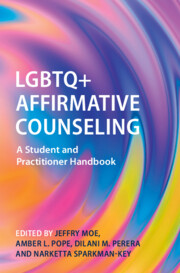Book contents
- LGBTQ+ Affirmative Counseling
- LGBTQ+ Affirmative Counseling
- Copyright page
- Contents
- Figure
- Tables
- Box
- Contributors
- Part I Foundations of LGBTQ+ Affirmative Counseling
- Part II LGBTQ+ Lifespan Development and Family Dynamics
- 5 Lifespan Development for Transgender and Gender-Diverse People
- 6 Sexual-Affectional Orientation Lifespan Development
- 7 Historical Perspectives on Gender Identity Development
- 8 Historical Perspectives on Sexual-Affectional Identity Development
- 9 Family and Relationship Dynamics and LGBTQ+ Mental Health
- Part III Assessment and Treatment in LGBTQ+ Affirmative Counseling
- Part IV New Directions in LGBTQ+ Affirmative Counseling
- Index
- References
8 - Historical Perspectives on Sexual-Affectional Identity Development
from Part II - LGBTQ+ Lifespan Development and Family Dynamics
Published online by Cambridge University Press: 31 October 2024
- LGBTQ+ Affirmative Counseling
- LGBTQ+ Affirmative Counseling
- Copyright page
- Contents
- Figure
- Tables
- Box
- Contributors
- Part I Foundations of LGBTQ+ Affirmative Counseling
- Part II LGBTQ+ Lifespan Development and Family Dynamics
- 5 Lifespan Development for Transgender and Gender-Diverse People
- 6 Sexual-Affectional Orientation Lifespan Development
- 7 Historical Perspectives on Gender Identity Development
- 8 Historical Perspectives on Sexual-Affectional Identity Development
- 9 Family and Relationship Dynamics and LGBTQ+ Mental Health
- Part III Assessment and Treatment in LGBTQ+ Affirmative Counseling
- Part IV New Directions in LGBTQ+ Affirmative Counseling
- Index
- References
Summary
This chapter delves into the historical perspectives on sexual-affectional identity development, encompassing key aspects such as the development of terminology, significant dates and events for sexual-affectional identity minoritized groups, cross-cultural perspectives, the role of helping professions in marginalization, and a critical review of models of sexual-affectional identity development. By exploring historical shifts in language and conceptualization, students gain a comprehensive understanding of the evolution of key terms used to describe sexual-affectional identity. The chapter critically evaluates the role of helping professions in perpetuating marginalization and discrimination against sexually minoritized individuals, emphasizing the need for ethical and inclusive practices within clinical mental health counseling. The chapter critically appraises existing models of sexual-affectional identity development, questioning linear and stage-based frameworks. Students will employ alternative models that recognize the fluidity, intersectionality, and diverse experiences within sexual-affectional identity development. Finally, this chapter provides graduate-level students with the historical, cultural, and theoretical foundations to approach sexual-affectional identity development from a comprehensive and inclusive clinical mental health counseling perspective. It enables them to better support and advocate for individuals with intersectional, minoritized sexual-affectional identities in their professional practice.
- Type
- Chapter
- Information
- LGBTQ+ Affirmative CounselingA Student and Practitioner Handbook, pp. 130 - 151Publisher: Cambridge University PressPrint publication year: 2024

